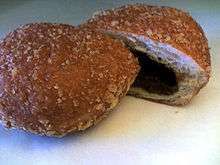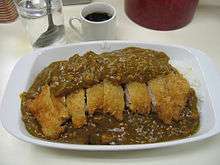Japanese curry
|
A plate of Japanese style curry with rice | |
| Type | Curry |
|---|---|
| Place of origin | Japan |
| Main ingredients | Vegetables (onions, carrots, potatoes), meat (beef, pork, chicken) |
| Variations | Karē raisu, karē udon, karē-pan |
|
| |
Curry (カレー karē) is one of the most popular dishes in Japan.[1] It is commonly served in three main forms: curry rice (カレーライス karē raisu, curry over rice), curry udon (curry over noodles), and curry bread (a curry-filled pastry). Curry rice is most commonly referred to simply as "curry" (カレー karē).
A wide variety of vegetables and meats are used to make Japanese curry. The basic vegetables are onions, carrots, and potatoes. For the meat, beef, pork, and chicken are the most popular. Katsu-karē is a breaded deep-fried cutlet (usually pork or chicken) with curry sauce.[2]
Curry was introduced to Japan during the Meiji era (1868–1912) by the British, at a time when India was under the colonial rule of British Raj. The dish became popular and available for purchase in supermarkets and restaurants in the late 1960s. It has been adapted since its introduction to Japan, and is so widely consumed that it can be called a national dish.[1]
Overview
As curry was introduced to Japan via British cuisine, it was originally considered to be Western cuisine. This Western-style curry co-exists alongside Indian-style curry, which has become popular since the increase in Indian restaurants in the 1990s. Western-style curry is influenced by stews mixed with curry powder, which were popular amongst the British Navy. The Imperial Japanese Navy adopted curry from the Royal Navy to prevent beriberi, and now the Japan Maritime Self-Defense Force's Friday menu is curry.[3]
Sauce mixes
Curry sauce (カレーソース karē sōsu) is served on top of cooked rice to make curry rice. Curry sauce is made by frying together curry powder, flour, and oil, along with other ingredients, to make roux; the roux is then added to stewed meat and vegetables, and then simmered until thickened. Adding potatoes to curry sauce was introduced by William S. Clark of the Sapporo Agricultural College, due to rice shortages at the time.
In Japanese homes, curry sauce is most commonly made from instant curry roux, which is available in block and powder forms, and contains curry powder, flour, oils and various flavourings. Ease of preparation, and the wide variety and availability of instant curry mixes, has made curry rice very popular, as it is very easy to make compared to many other Japanese dishes. Pre-made curry is available in vacuum-sealed bags that can be reheated in boiling water.
Instant curry roux was first sold in powder form by House Foods in 1926, and in block form by S&B Foods in 1956. In 2007, Japanese domestic shipments of instant curry roux was 82.7 billion yen.[4] Market share for household use in 2007 was captured almost entirely by House Foods (59.0%), S&B Foods (25.8%) and Ezaki Glico (9.4%).[5][6]
Vacuum-sealed curry sauce, prepared by heating the retort pouch in hot water or the microwave, is also popular. As of financial 2007, curry sauce is the largest single category of vacuum-sealed foods in Japan, making up over 30% of sales.[4]
Sides
Curry rice is usually served with fukujinzuke or rakkyō on the side.
Other varieties


- katsu karē (カツカレー?) : curry rice served with a breaded pork cutlet on top.
- dorai karē (ドライカレー?) : curry-flavored fried rice, or curry rice with a drier, mince meat curry sauce.
- maze karē (混ぜカレー?) : curry rice, served with the sauce and rice already mixed. Popularized by the Jiyūken (自由軒?) curry restaurants in Osaka.
- karē don (カレー丼?) : curry sauce, thickened and flavored with mentsuyu or hondashi and served on top of a bowl of rice, to give the curry a Japanese flavor.
- aigake (合がけ?) : rice served with curry sauce and hayashi sauce (fried beef and onion, cooked with red wine and demi-glace).
- yaki karē (焼きカレー?) : curry rice, topped with a raw egg and baked in an oven. Originally from Kitakyushu.
- ishiyaki karē (石焼きカレー?) : curry sauce with rice served in a heated stone bowl, in a similar way to dolsot bibimbap.
- sūpu karē (スープカレー?) : soup curry, a watery, broth-like curry sauce served with chunky ingredients such as a chicken leg and coarsely-cut vegetables. Popular in Hokkaido.
Local curries
In the late 1990s, a number of regional specialty curries emerged, popularised as vacuum-sealed curry sauces. These include:
- Hokkaido Sika Deer curry (えぞ鹿カレー ezoshika karē) from Hokkaido
- Scallop curry (ほたてカレー hotate karē) from Aomori Prefecture
- Mackerel curry (サバカレー saba karē) from Chiba Prefecture
- Apple curry (リンゴカレー ringo karē) from Nagano Prefecture and Aomori Prefecture
- Nattō curry (納豆カレー nattō karē) from Mito, Ibaraki
- Nagoya Kōchin Chicken curry (名古屋コーチンチキンカレー Nagoya kōchin chikin karē) from Aichi Prefecture
- Matsusaka beef curry (松阪牛カレー Matsusaka gyū karē) from Mie Prefecture
- Whale curry (クジラカレー kujira karē) from Wakayama Prefecture
- Oyster curry (牡蠣カレー kaki karē) from Hiroshima Prefecture
- Nashi pear curry (梨カレー nashi karē) from Shimane Prefecture
- Black pork curry (黒豚カレー kurobuta karē) from Kagoshima Prefecture
- Bitter melon curry (ゴーヤーカレー gōyā karē) from Okinawa
Local curries are also being marketed to help boost tourism. Some varieties of this include Yokosuka navy curry (よこすか海軍カレー Yokosuka kaigun karē), sold in Yokosuka to promote its heritage as a naval base,[7] and Zeppelin Curry (ツェッペリンカレー Tsepperin Karē) in Tsuchiura to promote the Zeppelin landing in 1929.
Events
Every year on 25 September, the Matsumotoro Restaurant (松本楼) in Hibiya Park holds a famous 10-yen curry buffet for charity, to commemorate the re-opening of the restaurant in 1973 after it was burnt down during demonstrations in 1971 against the return of Okinawa to Japan by the United States.
Outside Japan
South Korea
Curry was introduced to South Korea during the period of Japanese rule, and is popular there. It is often found at bunsik restaurants (diner-style establishments), donkkaseu-oriented restaurants, and at the majority of Japanese restaurants. Premade curry and powdered mixes are also readily available in supermarkets.
North Korea
Japanese-style curry was introduced to North Korea by Koreans and Japanese who migrated from Japan to North Korea during the 1960s-1970s repatriation project.[8] Along with other Japanese cuisine, it was traded by new arrivals for local products and used to bribe Worker's Party cadres.[8]
Elsewhere
Mixes can be found outside Japan and Korea in supermarkets that have a Japanese section or in Japanese or Asian food stores.
The largest Japanese curry company in Japan is House Foods Corporation. The company operates more than 10 Curry House Restaurants in the USA. Its associated company CoCo Ichibanya (Ichibanya Co., Ltd.) or Kokoichi has more than 1,200 restaurants in Japan. CoCo Ichibanya has branches in Hawaii (USA), California (USA), China, Hong Kong, Taiwan, Korea, Singapore, Indonesia, Philippines and Thailand.[9]
Serving
Japanese curry rice is served in anything from a flat plate to a soup bowl. The curry is poured over rice in any manner and amount. Japanese short grain rice, which is sticky and round, is preferred, rather than the medium grain variety used in Indian and Chinese dishes. It is usually eaten with a spoon, as opposed to chopsticks, because of the liquid nature of the curry, and is usually served garnished with vegetables pickled in vinegar such as fukujinzuke or rakkyo.
See also
References
| Wikimedia Commons has media related to Japanese Curry. |
- 1 2 『カレーライス』に関するアンケート (in Japanese). ネットリサーチ ディムスドライブ. Retrieved 2016-02-01.
- ↑ "Chicken katsu curry". Food recipes. BBC. 2016. Retrieved 20 January 2016.
- ↑ Curry Recipe Japan Maritime Self-Defense Force (Japanese)
- 1 2 生産量の推移 [Transition of Production] (in Japanese). All Japan Curry Manufacturers Association. Retrieved March 7, 2011.
- ↑ ハウス食品 [Hause Foods] (PDF) (in Japanese). Keio University Marketing Research Study Group. Retrieved March 7, 2011.
- ↑ コンサルティングレポート 江崎グリコ株式会社 [Proposal for Ezaki Glico] (PDF) (in Japanese). Kutsuna Seminar at Faculty of Business Administration in Kobe University. Retrieved March 7, 2011.
- ↑ Trautlein, Steve, "The chow-down tour of Kanto's local dishes", The Japan Times, 24 August 2012, p. 15
- 1 2 Bell, Markus (2016-04-08). "From India To North Korea, Via Japan: Curry's Global Journey". The Salt. NPR. Retrieved 2016-05-12.
- ↑
